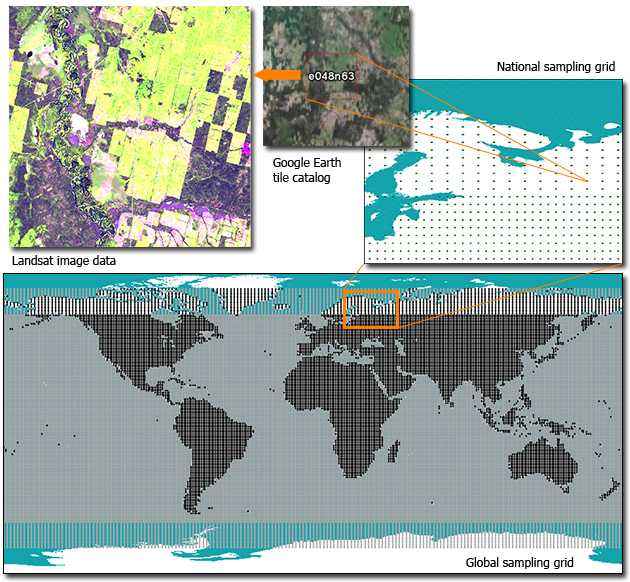|
Sampling Design
Sampling
The global sampling grid covers the latitude range between 75 degrees North/South. A systematic sampling design based on each longitude and latitude intersection has been implemented, with a reduced intensity above 60 degrees North/South latitude due to the curvature of the Earth (every second intersection sampled in between 60 and 75 degrees North/South). Specifically, every even longitude within the range of 180 degrees West to 178 degrees East and all intersections between 75 degrees North to 75 degrees South were sampled. Every odd longitude within the range of 179 degrees West to 179 degrees East and all intersections between 60 degrees North and 60 degrees South were also sampled.
Projection
The Universal Transverse Mercator (UTM) projection was used for data distribution. For the Southern Hemisphere, no false northing (y-axis point-of-origin shift) was implemented. The use of negative coordinates in Southern Hemisphere is consistent with Landsat data provided by USGS and simplifies working with data in ESRI, Leica Geosystems (ERDAS) and PCI software. For every sampling point, the UTM zone was specified. For intersection points overlapping with UTM zone boundaries, the Eastern zone was selected. The name (Tile ID) of the intersection was created using the pattern: e/w000n/s00. The UTM coordinates (meters, with 1 cm precision) were calculated for every sampling tile center point.
Tile boundaries
The extent of each sampling tile was defined to preserve an integer number of Landsat data pixels (30m spatial resolution). For 10x10km blocks, 334x334 pixels tiles were created for a tile extent of 10,020x10,020m. For 20x20km blocks, 668x668 pixels tiles were created for a tile extent of 20,040x20,040m.
Land tiles
Tiles were included based on the the VMAP0 (Vector Map Level 0, United States National Imagery and Mapping Agency) political boundaries data layer. Antarctica was excluded from the land mask. All 10x10km tiles overlapping with the VAMP0 land mask were selected as Land tiles.
|
 |


